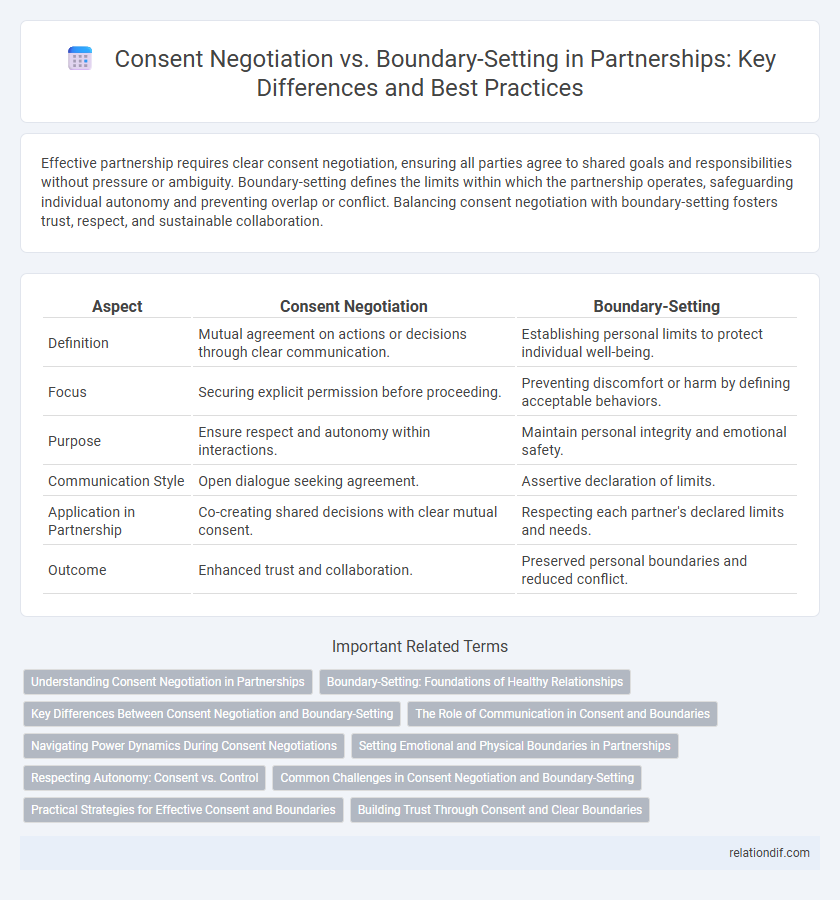Effective partnership requires clear consent negotiation, ensuring all parties agree to shared goals and responsibilities without pressure or ambiguity. Boundary-setting defines the limits within which the partnership operates, safeguarding individual autonomy and preventing overlap or conflict. Balancing consent negotiation with boundary-setting fosters trust, respect, and sustainable collaboration.
Table of Comparison
| Aspect | Consent Negotiation | Boundary-Setting |
|---|---|---|
| Definition | Mutual agreement on actions or decisions through clear communication. | Establishing personal limits to protect individual well-being. |
| Focus | Securing explicit permission before proceeding. | Preventing discomfort or harm by defining acceptable behaviors. |
| Purpose | Ensure respect and autonomy within interactions. | Maintain personal integrity and emotional safety. |
| Communication Style | Open dialogue seeking agreement. | Assertive declaration of limits. |
| Application in Partnership | Co-creating shared decisions with clear mutual consent. | Respecting each partner's declared limits and needs. |
| Outcome | Enhanced trust and collaboration. | Preserved personal boundaries and reduced conflict. |
Understanding Consent Negotiation in Partnerships
Consent negotiation in partnerships involves ongoing, clear communication where both parties openly discuss their needs, limits, and desires to ensure mutual agreement. This process fosters trust and respect by prioritizing active listening and confirming enthusiastic consent rather than assuming boundaries are fixed or implicit. Understanding consent negotiation is vital for creating a dynamic, responsive partnership that adapts to evolving emotional and physical comfort levels.
Boundary-Setting: Foundations of Healthy Relationships
Boundary-setting establishes clear limits that define personal and relational comfort zones, preventing misunderstandings and fostering respect. It involves communicating non-negotiable needs and expectations, which strengthens trust and emotional safety within partnerships. Effective boundary-setting supports long-term relational health by balancing individual autonomy with mutual support.
Key Differences Between Consent Negotiation and Boundary-Setting
Consent negotiation involves actively discussing and agreeing upon specific actions or agreements between partners, often focusing on what is permissible in a shared interaction. Boundary-setting establishes personal limits and non-negotiables that define individual comfort zones and emotional safety within the partnership. The key difference lies in consent negotiation being a dynamic process tailored to particular scenarios, while boundary-setting provides consistent, overarching guidelines for behavior.
The Role of Communication in Consent and Boundaries
Effective communication is essential in partnership dynamics for both consent negotiation and boundary-setting, ensuring clarity and mutual understanding. Consent negotiation involves ongoing dialogue to establish specific agreements, while boundary-setting requires explicit articulation of personal limits and expectations. This communication fosters trust and respect, reducing conflicts and promoting a healthier, more collaborative relationship.
Navigating Power Dynamics During Consent Negotiations
Navigating power dynamics during consent negotiations requires clear communication and mutual respect to ensure all parties feel safe and heard. Establishing boundaries early enhances trust and prevents misunderstandings by allowing individuals to express limits without coercion. Recognizing the influence of power imbalances helps create an equitable environment where consent is freely given and authentically maintained.
Setting Emotional and Physical Boundaries in Partnerships
Setting emotional and physical boundaries in partnerships is essential for fostering mutual respect and trust. Clear communication about personal limits helps prevent misunderstandings and supports individual autonomy. Consistent boundary-setting encourages a healthy dynamic where both partners feel safe and valued.
Respecting Autonomy: Consent vs. Control
Respecting autonomy in partnership hinges on distinguishing consent negotiation from boundary-setting, where consent negotiation emphasizes mutual agreement and ongoing willingness, ensuring all parties actively participate in decision-making. Boundary-setting focuses on establishing personal limits to protect individual integrity without imposing control over others. Prioritizing consent fosters shared control and empowerment, while boundary-setting safeguards autonomy by preventing overreach and maintaining personal sovereignty.
Common Challenges in Consent Negotiation and Boundary-Setting
Common challenges in consent negotiation and boundary-setting often involve miscommunication, differing personal values, and unclear expectations, which can lead to discomfort or conflict in partnerships. Power imbalances may hinder open dialogue, making it difficult for all parties to express their needs or concerns freely. Consistently revisiting and renegotiating boundaries requires trust, active listening, and mutual respect to foster a cooperative and healthy partnership environment.
Practical Strategies for Effective Consent and Boundaries
Effective consent negotiation involves clear, open communication where all parties explicitly express their needs and limits, creating a foundation of mutual respect. Boundary-setting requires proactive identification and firm articulation of individual limits to prevent misunderstandings and ensure emotional safety. Practical strategies include regular check-ins, using specific language to define acceptable behaviors, and fostering an environment where consent can be withdrawn or modified without judgment.
Building Trust Through Consent and Clear Boundaries
Building trust in partnerships hinges on transparent consent negotiation and clear boundary-setting, which foster mutual respect and understanding. Explicitly communicating limits and expectations prevents misunderstandings and reinforces commitment to each other's autonomy. Establishing consistent consent practices creates a safe environment where all parties feel valued and secure.
consent negotiation vs boundary-setting Infographic

 relationdif.com
relationdif.com